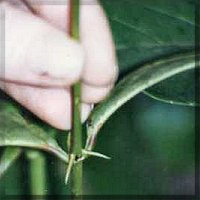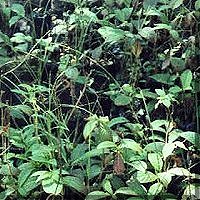


Uncaria tomentosa



Uncaria tomentosa
Synonyms - hawk's claw uña de gato, paraguayo, garabato, garbato casha, samento, saventaro, toroñ, tambor huasca, uña huasca, uña de gavilan, hawk's claw, vilcacora
Description - Uncaria tomentosa, commonly known in Spanish as uña de gato and in English as "cat’s claw," is a vine found wrapped around the trees in the rainforest of Peru. Historically uña de gato was used by natives as a tribal medicine for arthritis, gastritis, cancer and other diseases. Recent research, indicates that the constituents of cat’s claw may contain properties that aid the digestive and immune systems. Uña de gato grows wild in the highlands of the Peruvian Amazon in South America, is a giant, woody vine that grows more than 100 feet tall. It is a slow growing vine taking 20 or more years to reach maturity. It is called cat’s claw because the thorns found on the vine closely resemble the claws of a cat. There are many species of Uncaria. Uncaria guinanensis and U. tomentosa are two common ones native to the jungle regions of Peru, from the Amazon Basin south to the high jungle areas of the province of Junin. Uncaria tomentosa grows in the foothills, predominantly at altitudes of two to eight thousand feet. Uncaria guinanensis, a lowland species, is abundant in lower altitudes of the Peruvian rainforests. Uncaria tomentosa is the better known of the two because of its medicinal properties.
Parts used - The bark and roots have been used for hundreds, perhaps thousands of years by the native Ashanica Indians for treatment of a wide variety of health problems associated with the immune and digestive systems. Today, bark (which has all the medicinal properties) from the vine is typically the part used for medicinal purposes and the root is spared in order to avoid killing the plant, so protecting the Amazon Rainforest.
History - Uña de gato was rediscovered by Klaus Keplinger during a trip to Peru in 1974. Keplinger learned of its reputation for effectiveness through conversation with an Ashanica Indian working with doctors in the jungle. Since then, in many countries throughout the world, research has been conducted on this remarkable plant. There are those who believe uña de gato has several alkaloids that may yield profound healing abilities. According to the patent, four alkaloids have been proven "suitable for the unspecific stimulation of the immune system." Again according to the patent, the most immunologically active one, is the alkaloid, isopteropodin. Keplinger’s research shows four of these alkaloids to have a pronounced enhancement effect on phagocytosis, which is the ability of white blood cells and macrophages to attack, engulf and digest harmful micro-organisms, foreign matter and debris.
Pharmacological - Italian and Peruvian researchers have isolated several polyphenols, triterpines, and the plant steroids beta-sitosterol, stigmasterol and campesterol. The presence of these additional compounds may explain uña de gato’s believed antioxidant, antiviral, antitumor and anti-inflammatory properties. Research has found that the Uncaria tomentosa exerts a protective action ("Uña de gato showed no mutagenic effect and displayed significant antimutagenic activity as an antioxidant."). Cat's claw has several groups of plant chemicals that account for much of the plant's actions and uses.
Austrian Research Scientist Klaus Keplinger has shown the herb contains six important oxindole alkaloids. Four of these, Isopteropodine, Pteropopine, Isomitraphylline, and Isorynchophylline, help the white blood cells dispose of harmful microorganisms and cell debris.
A fifth alkaloid, Rynchophylline, examined by Chinese researchers, shows this component may be a practical agent in the prevention of cardiac problems by reducing blood pressure, increasing circulation, and inhibiting the accumulation of Arteriosclerosis plaque and blood clots.
Quinovic acid glycosides have documented anti-inflammatory and antiviral actions. Antioxidant chemicals (tannins, catechins and procyanidins) as well as plant sterols (beta-sitosterol, stigmasterol, and campesterol) account for the plant's anti-inflammatory properties. A class of compounds known as carboxyl alkyl esters found in cat's claw has been documented with immunostimulant, anti-inflammatory, anticancerous, and cell-repairing properties. Cat's claw contains ajmalicine, akuammigine, campesterol, catechin, carboxyl alkyl esters, chlorogenic acid, cinchonain, corynantheine, corynoxeine, daucosterol, epicatechin, harman, hirsuteine, hirsutine, iso-pteropodine, loganic acid, lyaloside, mitraphylline, oleanolic acid, palmitoleic acid, procyanidins, pteropodine quinovic acid glycosides, rhynchophylline, rutin, sitosterols, speciophylline, stigmasterol, strictosidines, uncarine A thru F, and vaccenic acid.
Additionally, Cat’s Claw is a storehouse of other health-enhancing phytochemicals. These include Proanthocyanidins, Triterpines, Polyphenols, Quinovic Acid Glycosides and the plant Sterls Beata Sitosterol, Stigmasterol and Campesterol. These might account for the antioxidant, cholesterol-inhibiting, immune-boasting anti-tumor and anti-inflammatory action attributed to this herb.
Medicinal use - An isolate of the uña de gato plant is being used successfully in other countries such as Austria and Germany for the treatment of AIDS and cancer. It is tused to help those suffering from a variety of stomach and bowel disorders. These disorders include: Crohn’s disease, ulcers, gastritis, parasites, diverticulitis, hemorrhoids, leaky bowel syndrome and intestinal flora imbalance. Indian folklore tells that uña de gato, also used in the form of tea, has been successful in curing tumors and other known deadly diseases. The Indians of this native land regard Uncaria tomentosa as a sacred herbal panacea. Spanish labels often recommend uña de gato for the treatment of cancer, arthritis, gastritis and female hormonal imbalances.
Uncaria tomentosa principal proposed uses at this time are treatment for:
Various Viral Dseases - On November 28, 1988 and June 17, 1993, articles regarding Uncaria tomentosa as an extract called "Krallendon" (a drug) appeared in El Commercio, a major metropolitan newspaper in Lima, Peru. Krallendon is being tested at Immodel, an Australian laboratory, by Dr. Keplinger, the director. The articles discussed Dr. Keplinger’s success in using Uncaria tomentosa to treat allergies, neurobronchitis, genital herpes and herpes zoster.
Other applications where cat’s claw is thought to be beneficial include:
Dosage - three to six grams a day could be used for therapeutic dosages, and studies have used up to 20 grams a day for those seriously afflicted with illness and disease.
Pharmacology - Numerous investigations have been carried out to isolate and determine secondary metabolites of Uncaria tomentosa. So far, over fifty identified compounds have been already reported including oxindole alkaloids (speciophylline, mitraphylline, uncarine F, pteropodine, isomitraphylline, uncarine E), ursane type pentacyclic triterpenes with a variety of ursolic acid derivatives, quinovic acid glycosides, sterols and procyanidins. Besides isopteropodin and the other immune-stimulating alkaloids, rynchophylline is another alkaloid found in uña de gato. Research suggests rynchophylline has the ability to inhibit platelet aggregation and thrombosis. These findings suggest rynchophylline may aid in preventing strokes and reducing the risk of heart attacks by lowering blood pressure, increasing circulation and inhibiting the formation of plaque on the arterial walls and the formation of blood clots in the vessels of the brain, heart and arteries.
Cat's claw contains ajmalicine, akuammigine, campesterol, catechin, carboxyl alkyl esters, chlorogenic acid, cinchonain, corynantheine, corynoxeine, daucosterol, epicatechin, harman, hirsuteine, hirsutine, iso-pteropodine, loganic acid, lyaloside, mitraphylline, oleanolic acid, palmitoleic acid, procyanidins, pteropodine quinovic acid glycosides, rhynchophylline, rutin, sitosterols, speciophylline, stigmasterol, strictosidines, uncarines, and vaccenic acid.,
Contra-indications - Uña de gato is contraindicated for transplant carriers because of possible graft rejection. During pregnancy, or if nursing, uña de gato should not be used.